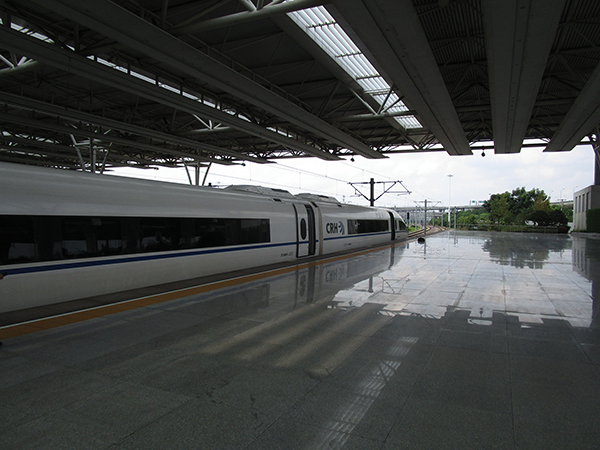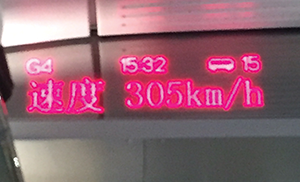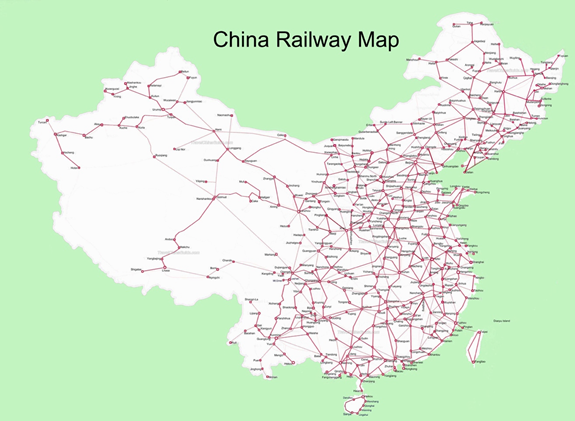Combining our Interest in Lighting and our Fascination with China

Lightning Catches Bullet
Mike Violette
Pan frantically pulled on the emergency lever, but too late and to no avail. Traveling just over 30 meters per second, the nacelle of high speed Train D301 closed the last millimeter separating it from the stalled train ahead in just over 30 nanoseconds.
The resulting impact crumpled the carriages of the trains, crushed bodies and baggage and tossed four cars off a viaduct. The hapless engineer was impaled on the lever of the useless brake, his last thoughts were: “我死了.”
China Railway High Speed Rail
Spread out over 12,000 miles of track, the Chinese High Speed Rail (HSR)—Gao Tie 高铁 or “Big Iron”— represents an amazing infrastructure build in this country of 1.5 billion souls. Starting in earnest in 2007, the system has more high speed train routes than the rest of the world combined. The entire HSR carries 400 million people a year, cutting travel times between cities by as much as two-thirds, with some routes largely replacing airplane service.
In comparison, AMTRAK operates over 21,300 miles of track—built during the 20th century—and carries around 31 million passengers per year.
Total investment in the system is on the order of $250 billion: “shovel ready” anyone? The pace of development of the system is at nothing less than ‘breakneck’ speed.
The trains, carrying upwards of 1000 people and stretching a quarter of a mile, can run at a maximum speed of 350 km/hour, however the top speeds have been reduced since a 2011 collision between speeding D301 and stalled D3115 over a viaduct in Wenzhou.
Current peak velocities are 305 km/hour as I witnessed recently on a Shanghai-Beijing run.

The zippiest versions of the state-of-the-art trains can achieve a blistering 487km/hr (303 mph), about twice as fast as the quickest AMTRAK trains in the US, which operates fast(er) “leaning trains” on a few select routes.1
Although much of the initial “bullet train” technology had been imported from Canada, Germany, Japan and Italy under various technology transfer deals, China has started to implement their own versions and, as is their wont, have made modifications and domesticized the technology. This includes the communications and signaling systems that were built to control the thousand or so trips the trains make each day.
The system knits the country together, modernizing its critical transportation resources. As part of the government stimulus following the 2008 recession, China pumped a ton of cash into the economy. The ministry that operates the system employs about 25,000 workers. The build out included the development of new signaling systems— critical parts of the safety design of the system—although I am not sure of the EMC testing that was performed.

The Beijing-Shanghai link, which gets you a nice seat for about 533 RMB (about 90 bucks), cost around $32 billion to construct and gets you city-to-city in smooth fashion in about 4 hours, as friendly attendants serve fruit, noodles, beer and ice cream. The Shanghai Hangqiao station teems with people any given day and is one of the biggest train/plane hubs in the world.
Any project of this size is going to have some problems and in 2011, it was a stroke of lightning that squeezed the brakes on the development of the HSR.
Faster than a Bullet

A million volts and 25 thousand amps are generated during a typical lightning strike. The phenomenology of nature’s oldest EMI Beast is quite fascinating, notably the physics that govern the discharge as it approaches the ground.2 The massive neutralization of charge that occurs during a lightning event (which is what happens when Thor tosses his thunderbolts) takes place over the course of 100 microseconds (for each stroke) with the total air-to-ground intercourse lasting a few seconds. There may be several exchanges between the sky and Earth over the ionized channel until balance is momentarily achieved.
When sufficient potential builds up from grounded objects to the atmosphere, a so-called “stepped leader” stroke descends from the clouds reservoir of charge. A “return stroke” launches to meet the leader stroke to neutralize the charge in the leader channel. It’s all about getting the positive and negative together, it just takes a few dozen kilo-amperes of current to accomplish.
The problem is that while the coulombs are balanced, the resulting induction jerks around potentials in metallic objects in the local area, causing currents to flow in conductors for many hundreds and thousands of meters. Not properly managed, these currents can impose local voltage differences in equipment, cables and internal wiring. It is this effect, and the resultant surges that caused equipment malfunction on the track carrying trains D301 and D3115 on Pan’s last day on the planet.
May 9, 1421: Beijing, China
Lightning has troubled China in the past. During the pinnacle of the Ming Dynasty a few bolts hit the Forbidden City in the heart of Beijing. The newly-built palace burned to the ground.
This was during the explorations of the famed seafaring eunuch (talk about taking one for the boss) named Zheng He. As Admiral of the Ming Dynasty “treasure fleets” Zheng visited much of Southeast Asia, India and Africa (and, according to some, America3). Zheng’s fleets, numbering several hundreds of vessels, carried some 20,000 men, horses and livestock. The largest ships were upwards of 500 feet long and would dwarf the vessels that Columbus rode to Hispaniola some 70 years later.
Anyway, seems there was a change in top management in Forbidden City and the new Emperor at the time interpreted/used the lightning and resulting conflagration as a sign from God that China should not be adventuring abroad. He called Zheng back and scuttled the fleet. The explorations were probably and more likely stopped for financial reasons and the growing rise of Mongol threats,4which turned the Ming to Qing.
Lightning, capricious and devilish, would vex China again almost 600 years after Zheng hung up his maozi.
July 23, 2011: Wenzhou, China
As with many a disaster, not a single incident led to the tragedy, but a sequence of events caused the wreck and subsequent loss of 40 lives. From an analysis of the crash, it appears that D3115 was halted because a lightning strike(s) caused a loss of power as it crossed a viaduct in Wenzhou. That was the first link in the disaster chain. Then, because of a second strike that caused communication equipment to malfunction, the dispatch operations were routed to a manual procedure. However, the engineer of the stalled train had difficulty communicating with the central control.
The engineer attempted to restart the train, but it took several attempts and it moved out in “safe” speed of just 20km/hour. The lightning strike(s) also blew fuses in a signaling circuit that erroneously posted a “green/go” indication back to the system and to the operator of D301, which pulled out of the station expecting an open track. Pan, perhaps sensing that something was amiss, had slowed D301 down to about 60 mph. Coupled with the double lightning whammy, the confused communications and a failure of what should have been a “fail-safe” system, D301 plowed into the rear of D3115.
When the accident occurred D301 was moving at a mere 60 mph. It is troubling to imagine what would have happened if the train was at full-throttle (220 mph). Certainly the disaster would have been worse.
Ultimately, the resulting follow-up investigation raised great concern over the pace and, er, management of the CHR program.
Lightning was partly blamed for a sinking of the Treasure Fleets of Zheng He. It has not, however, stopped the Bullet Trains of China.
Endnotes
- AMTRAK web site
- The Lightning Striking Distance—Revisited” Vernon Cooraya, , Vladimir Rakovb, Nelson Theethayia. Journal of Electrostatics. 10 November 2006
- 1421: The Year China Discovered America. Gavin Menzies. June 3, 2008.
- http://asianhistory.about.com/od/china/f/zhenghefaq.htm
Originally Published in InCompliane Magazine September 30, 2016


